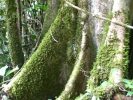 A Saravanan and Mathivanan, research associates with the Bengaluru-based Ashoka Trust for Research in Ecology and Environment, a scientific research organisation, have been investigating the history and ecological significance of the Nandavanams in Tirunelveli and Tuticorin districts. “These are similar to sacred groves in the rest of India,” said Saravanan.
A Saravanan and Mathivanan, research associates with the Bengaluru-based Ashoka Trust for Research in Ecology and Environment, a scientific research organisation, have been investigating the history and ecological significance of the Nandavanams in Tirunelveli and Tuticorin districts. “These are similar to sacred groves in the rest of India,” said Saravanan.
“Traditionally such gardens and forests, which surrounded the temple, would hold trees and plants that would be beneficial to the temple. For instance, they would provide oil to the lamps, medicines, fruits and flowers for worship.” While traditionally sacred groves existed before a temple did, Nandavanams were built around a temple. But functionally, they were similar. In their study of the ecological value of 61 temples, they found 135 species of shrubs and trees such as mahua, bael, neem, arjuna, jackfruit, Indian sandalwood, palash. In terms of biodiversity, they observed 51 bird species, 16 butterfly species and four mammals. “These gardens have a healthy population of native trees and they attract frugivores and small mammals,” said Mathivanan. “At least, it is not bougainvillea.”
Owing to their relatively longer history of formal protection of forests, sacred groves host unique assemblages of biodiversity – species and genes – that are not found elsewhere, kind of like a repository.
It is difficult to imagine being able to conserve all of India's biodiversity in formal protected areas, which cover less than 5% of our geographic area, It is important to utilise the potential of areas outside protected areas to conserve biodiversity. Although small and often fragmented, these networks can provide resources such as fruiting trees or nesting sites, as well as act as stepping stones for wildlife across human-used landscapes.” Osuri works primarily in the moist evergreen forests and forest fragments in Kodagu, Karnataka.


